Table of Contents
Editor: John DeNisco
FD.io (Fast data – Input/Output) is a collection of several projects that support flexible, programmable packet processing services on a generic hardware platform. FD.io offers a landing site with multiple projects fostering innovations in software-based packet processing towards the creation of high-throughput, low-latency and resource-efficient IO services suitable to many architectures (x86, ARM, and PowerPC) and deployment environments (bare metal, VM, container).
The core component is the Vector Packet Processing (VPP) library. VPP using “Vector Packet Processing” technology. The VPP library is highly modular, allowing for new graph nodes to be easily “plugged in” without changes to the underlying code base. This gives developers the potential to easily build any number of packet processing solutions.
FD.io's Vector Packet Processor (VPP) is a fast, scalable layer 2-4 multi-platform network stack. It runs in Linux user space on multiple architectures including x86, ARM, and Power architectures.
FD.io VPP is developed using vector packet processing, as opposed to scalar packet processing. Vector packet processing is a common approach among high performance packet
processing applications. The scalar based approach tends to be favored by network stacks that don't necessarily have strict performance requirements.
A scalar packet processing network stack typically processes one packet at a time: an interrupt handling function takes a single packet from a Network
Interface, and processes it through a set of functions: fooA calls fooB calls fooC and so on.
+---> fooA(packet1) +---> fooB(packet1) +---> fooC(packet1)
+---> fooA(packet2) +---> fooB(packet2) +---> fooC(packet2)
+---> fooA(packet3) +---> fooB(packet3) +---> fooC(packet3)
Scalar packet processing is simple, but inefficient in these ways:
In contrast, a vector packet processing network stack processes multiple packets at a time, called 'vectors of packets' or simply a 'vector'. An interrupt handling function takes the vector of packets from a Network Interface, and processes the vector through a set of functions: fooA calls fooB calls fooC and so on.
+---> fooA([packet1, +---> fooB([packet1, +---> fooC([packet1, +--->
packet2, packet2, packet2,
... ... ...
packet256]) packet256]) packet256])
This approach fixes:
The further optimizations that this approaches enables are pipelining and prefetching to minimize read latency on table data and parallelize packet loads needed to process packets.
At the core of the FD.io VPP design is the Packet Processing Graph. The FD.io VPP packet processing pipeline is decomposed into a ‘Packet Processing Graph’. This modular approach means that anyone can ‘plugin’ new graph nodes. This makes VPP easily extensible and means that plugins can be customized for specific purposes.
The Packet Processing Graph creates software:
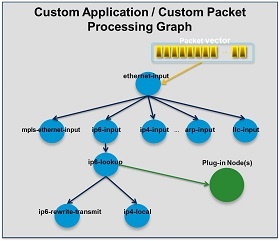
At runtime, the FD.io VPP platform assembles a vector of packets from RX rings, typically up to 256 packets in a single vector. The packet processing graph is then applied, node by node (including plugins) to the entire packet vector. The received packets typically traverse the packet processing graph nodes in the vector, when the network processing represented by each graph node is applied to each packet in turn. Graph nodes are small and modular, and loosely coupled. This makes it easy to introduce new graph nodes and rewire existing graph nodes.
Plugins are shared libraries and are loaded at runtime by FD.io VPP. FD.io VPP finds plugins by searching the plugin path for libraries, and then dynamically loads each one in turn on startup. A plugin can introduce new graph nodes or rearrange the packet processing graph. You can build a plugin completely independently of the FD.io VPP source tree, which means you can treat it as an independent component.
Most FD.io VPP features are written as plugins. The features include everything from layer 2 switching to a TCP/IP host stack. For a complete list of features please visit FD.io VPP features.
FD.io VPP supports and has tested most DPDK drivers (some have not been completely tested). FD.io VPP also has some native drivers most notablly VMXNET3 (ESXI), AVF (Intel), vhostuser (QEMU), virtue, tapv2, host-interface and Mellanox.
FD.io VPP supports entry hardware options from number of hardware vendors for building Customer Premise Equipment devices. FD.io VPP based commercial options are available from vendors such as Netgate with TNSR, Cisco with the ASR 9000, Carrier Grade Services Engine and many more.
These implementations are accelerated with DPDK Cryptodev for whole platform crypto.
FD.io VPP has a growing list of network traffic management and security features to support gateway uses cases such as Broadband Network Gateway.
FD.io VPP has a rich set of plugin’s to enhance its capabilities. Cloud load-balancing is just one of number of feature enhancing plugins available to the end user. For example: Google Maglev Implementation, Consistent Hashing, Stateful and stateless load balancing, Kube-proxy integration.
Fd.io VPP has four different Access Control List technologies; ranging from the simple IP-address whitelisting (called COP) to the sophisticated FD.io VPP Classifiers.
For more information on FD.io VPP please visit FD.io VPP.
There are several other notable FD.io projects. Some of them are listed here.
The Continuous System Integration and Testing (CSIT) project provides functional and performance testing for FD.io VPP. This testing is focused on functional and performance regressions. For more information on the CSIT project please visit the CSIT project pages. For the latest CSIT results please visit the CSIT report.
Hybrid Information-Centric Networking (hICN) is a network architecture that makes use of IPv6 or IPv4 to realize location-independent communications. A scalable stack is available based on VPP and a client stack is provided to support any mobile and desktop operating system. For more information on the hiCN project please visit the hiCN documents.
The Universal Deep Packet Inspection (UDPI) project is a reference framework to build a high performance solution for Deep Packet Inspection, integrated with the general purpose FD.io VPP stack. It leverages industry regex matching library to provide a rich set of features, which can be used in IPS/IDS, Web Firewall and similar applications. For more information on UDPI please visit UDPI wiki.
Dual Mode, Multi-protocol, Multi-instance (DMM) is to implement a transport agnostic framework for network applications that can
Use and engage or adopt a new protocol stack dynamically as applicable. For more information on DMM please visit the DMM wiki page.
Sweetcomb is a management agent written in C that runs on the same host as a VPP instance, and exposes yang models via NETCONF, RESTCONF and gNMI to allow the management of VPP instances. Sweetcomb works as a plugin (ELF shared library) for sysrepo datastore. For more information on Sweetcomb please the Sweetcomb wiki page.
For more information in the FD.io Project please visit FD.io or FD.io Documentation.
Editor: Chaker Al-Hakim
The Open Network Automation Platform (ONAP) project addresses the rising need for a common automation platform for telecommunication, cable, and cloud service providers—and their solution providers— that enables the automation of different lifecycle processes, to deliver differentiated network services on demand, profitably and competitively, while leveraging existing investments.
Prior to ONAP, telecommunication network operators had to keep up with the scale and cost of manual changes required to implement new service offerings, from installing new data center equipment to, in some cases, upgrading customer equipment on-premises. Many operators are seeking to exploit Software Defined Network (SDN) and Network Function Virtualization (NFV) to improve service velocity, simplify equipment interoperability and integration, and reduce overall CapEx and OpEx costs. In addition, the current, highly fragmented management landscape makes it difficult to monitor and guarantee service-level agreements (SLAs).
ONAP is addressing these challenges by developing global and massive scale (multi-site and multi-Virtual Infrastructure Manager (VIM)) automation capabilities for both physical and virtual network elements. It facilitates service agility by supporting data models for rapid service and resource deployment, by providing a common set of Northbound REST APIs that are open and interoperable, and by supporting model driven interfaces to the networks. ONAP’s modular and layered nature improves interoperability and simplifies integration, allowing it to support multiple VNF environments by integrating with multiple VIMs, virtualized network function managers (VNFMs), SDN Controllers, and even legacy equipment. ONAP’s consolidated VNF requirements enable commercial development of ONAP-compliant VNFs. This approach allows network and cloud operators to optimize their physical and virtual infrastructure for cost and performance; at the same time, ONAP’s use of standard models reduces integration and deployment costs of heterogeneous equipment, while minimizing management fragmentation.
ONAP enables end user organizations and their network or cloud providers to collaboratively instantiate network elements and services in a dynamic, closed control loop process, with real-time response to actionable events.
ONAP’s major activities, that is designing, deploying and operating services, are provided based on ONAP’s two major frameworks, namely on Design-time framework and Run-time framework:
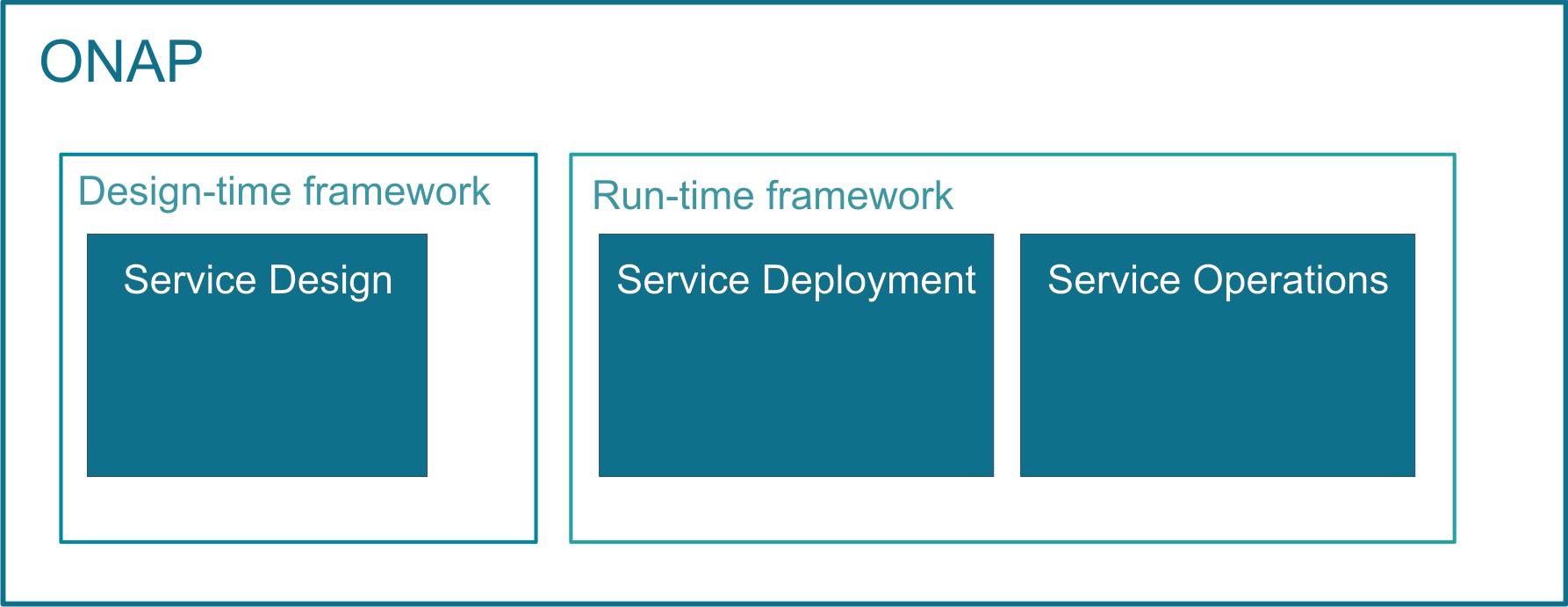
In order to design, deploy and operate services and assure these dynamic services, ONAP activities are built up as follows:
ONAP enables product- or service-independent capabilities for design, deployment and operation, in accordance with the following foundational principles:
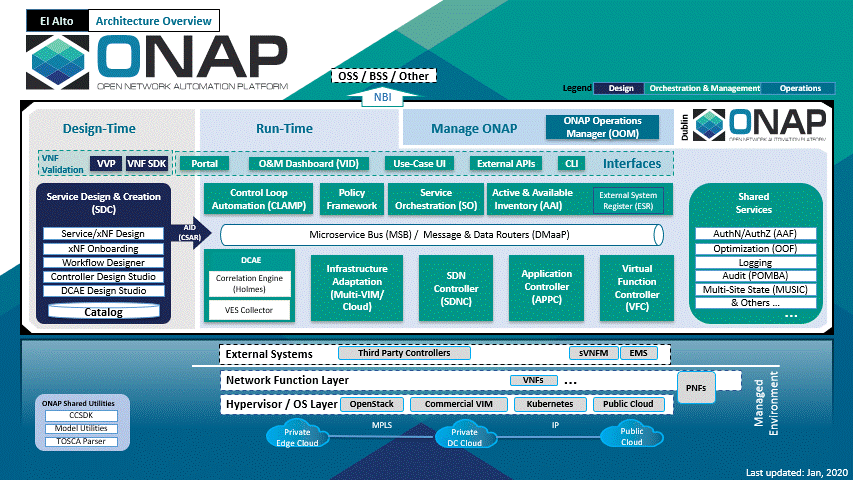
The above diagram shows the main ONAP activities in a chronological order.
ONAP supports Service Design operations, using the TOSCA approach. These service design activities are built up of the following subtasks:
Open Network Automation Platform provides the following benefits:
ONAP is enhanced with numerous features from release to release. Each release is named after a city. A list of past and current releases may be found here:
https://wiki.onap.org/display/DW/Long+Term+Roadmap
Editor: Abhijit Kumbhare
OpenDaylight (ODL) is a modular open platform for customizing and automating networks of any size and scale. The OpenDaylight Project arose out of the SDN movement, with a clear focus on network programmability. It was designed from the outset as a foundation for commercial solutions that address a variety of use cases in existing network environments.
The core of the OpenDaylight platform is the Model-Driven Service Abstraction Layer (MD-SAL). In OpenDaylight, underlying network devices and network applications are all represented as objects, or models, whose interactions are processed within the SAL.
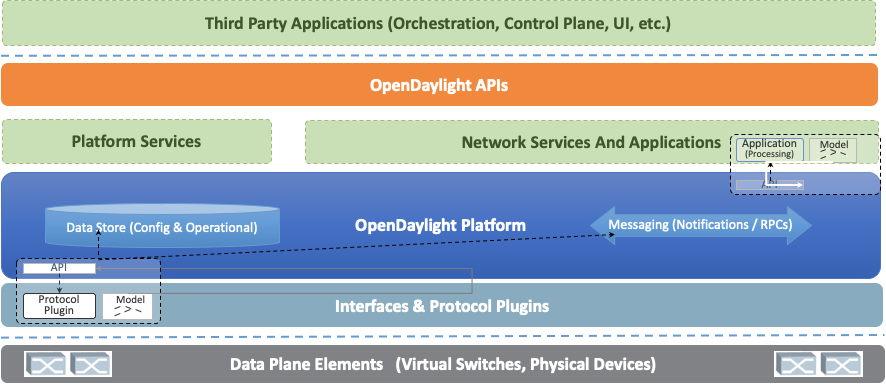
The SAL is a data exchange and adaptation mechanism between YANG models representing network devices and applications. The YANG models provide generalized descriptions of a device or application’s capabilities without requiring either to know the specific implementation details of the other. Within the SAL, models are simply defined by their respective roles in a given interaction. A “producer” model implements an API and provides the API’s data; a “consumer” model uses the API and consumes the API’s data. While ‘northbound’ and ‘southbound’ provide a network engineer’s view of the SAL, ‘consumer’ and ‘producer’ are more accurate descriptions of interactions within the SAL. For example, protocol plugin and its associated model can either be a producer of information about the underlying network, or a consumer of application instructions it receives via the SAL.
The SAL matches producers and consumers from its data stores and exchanges information. A consumer can find a provider that it’s interested in. A producer can generate notifications; a consumer can receive notifications and issue RPCs to get data from providers. A producer can insert data into SAL’s storage; a consumer can read data from SAL’s storage. A producer implements an API and provides the API’s data; a consumer uses the API and consumes the API’s data.
The ODL platform is designed to allow downstream users and solution providers maximum flexibility in building a controller to fit their needs. The modular design of the ODL platform allows anyone in the ODL ecosystem to leverage services created by others; to write and incorporate their own; and to share their work with others. ODL includes support for the broadest set of protocols in any SDN platform – OpenFlow, OVSDB, NETCONF, BGP and many more – that improve programmability of modern networks and solve a range of user needs.
Southbound protocols and control plane services, anchored by the MD-SAL, can be individually selected or written, and packaged together according to the requirements of a given use case. A controller package is built around four key components (odlparent, controller, MD-SAL and yangtools). To this, the solution developer adds a relevant group of southbound protocols plugins, most or all of the standard control plane functions, and some select number of embedded and external controller applications, managed by policy.
Each of these components is isolated as a Karaf feature, to ensure that new work doesn’t interfere with mature, tested code. OpenDaylight uses OSGi and Maven to build a package that manages these Karaf features and their interactions.
This modular framework allows developers and users to:
The modularity and flexibility of OpenDaylight allows end users to select whichever features matter to them and to create controllers that meets their individual needs.
As we saw, the OpenDaylight platform (ODL) provides a flexible common platform underpinning a wide variety of applications and Use Cases. Some of the most common use cases are mentioned here.
Leveraging the common code base provided by Common Controller Software Development Kit (CCSDK), ONAP hasprovides two application level configuration and lifecycle management controller modules called ONAP SDN-C and ONAP App-C . These controllers manage the state of a single Resource (Network or Application). Both provide similar services (application level configuration using NetConf, Chef, Ansible, RestConf, etc.) and life cycle management functions (e.g. stop, resume, health check, etc.). The ONAP SDN-C has been used mainly for Layer1-3 network elements and the ONAP App-C is being used for Layer4-7 network functions. The ONAP SDN-C and the ONAP App-C components are extended from OpenDaylight controller framework.
The ONAP SDN-C leverages the model driven architecture in OpenDaylight. As illustrated , the ONAP SDN-C leverages the OpenDaylight framework composed of API handlers, operational and configuration trees, and network adapters for network device configurations. Within this framework, the ONAP Service Logic Interpreter (SLI) newly introduced provides an extensible scripting language to express service logic through the Directed Graph builder based on Node-Red . The service logic is written how network service parameters (e.g. L3VPN) given from the northbound API are mapped onto network device configuration parameters consumed by external SDN controllers attaching to the ONAP SDN-C.
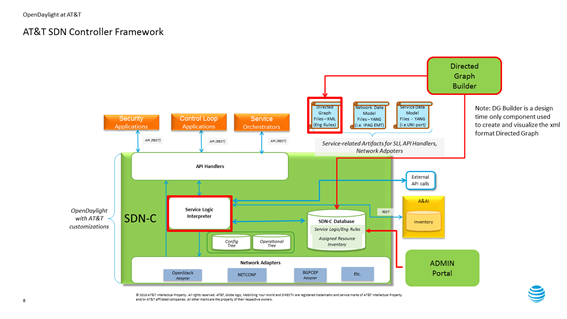
External SDN controller interfaces with the southbound interface of the ONAP SDN-C and is used to manage the Layer1-3 network devices in each network domain. Over the interface, the network configuration parameters extracted from the service logic are passed to the external SDN controllers. An OpenDaylight as an external SDN controller supports parameters for L3VPN, L2VPN, PCEP, NETCONF and more. The external OpenDyalight controller deploy the given configurations into the network devices.
OpenDaylight NetVirt App can be used to provide network virtualization (overlay connectivity) inside and between data centers for Cloud SDN use case:
The components used to provide Network Virtualization is shown in the diagram below:
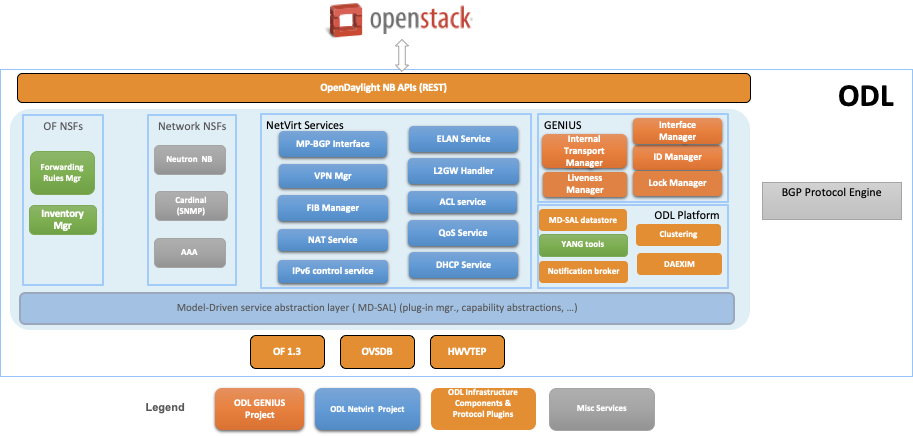
OpenDaylight can expose Network Services API for northbound applications for Network Automation in a multi vendor network.
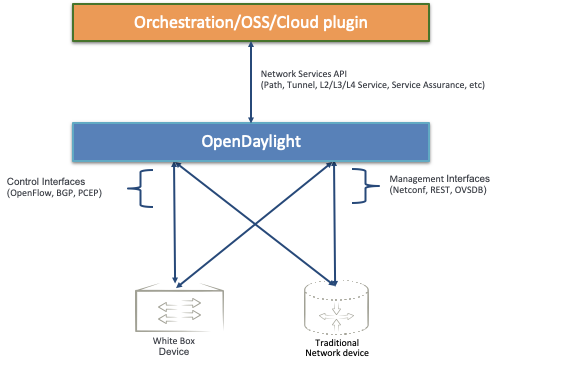
These are just a few of the common use cases but the platform can and continues to be tailored to several other use cases.
Editor: Mike Lazar
OpenSwitch (OPX) – an open source network operating system (NOS) and ecosystem - is an early adopter of emerging concepts and technologies (hardware and software disaggregation, use of open source, SDN, NFV and DevOps) which disrupt how networks and networking equipment are built and operated. Designed using a standard Debian Linux distribution with an unmodified Linux kernel, OpenSwitch provides a programmable high-level abstraction of network components, such as switching ASICs (Network Processors) and optical transceivers. Architected as a scalable, cloud-ready, agile solution, the open source OpenSwitch software implements a flexible infrastructure to enable both network operators and vendors to rapidly on-board open source Networking OS applications. OpenSwitch provides a YANG based programmatic interface, that can be accessed using Python, thus providing an environment well-suited for DevOps.
OpenSwitch (or OPX) provides an abstraction of hardware network devices in a Linux OS environment. It has been designed from its inception in order to support the newest technologies and concepts in the networking industry:
OpenSwitch can be deployed on diverse networking hardware – only the low-level software layers SAI (Switch Abstraction Interface) and System Device Interface (SDI) are hardware specific and may need to be adapted. A minimum requirement is for hardware to be build around a standard ASIC, with Layer 2 switching, Layer 3 routing, ACL and QoS functionality.
OpenSwitch provides support for:
OpenSwitch supports a rich ecosystem for automated deployment, for instance:
The OpenSwitch CPS programmatic interface is defined using YANG models, and in combination with Python, provides support for programming the network functionality, automation and DevOps. While the CPS API is the native OpenSwitch API, a REST API can be added as well, by mapping REST requests to CPS.
In addition, a set of OpenSwitch specific commands are available and can be invoked from a Linux shell (e.g. display the current software version, hardware inventory etc.).
The figure below illustrates the main areas of the OpenSwitch architecture:
The key components of OPX Base are:
NAS – Network Adaptation Service
PAS- Platform Adaptation Service
CPS – Control Plane Service
SAI – Switch Abstraction Interface
SDI – System Device Interface
A variety of open source or vendor specific applications have been tested and can be deployed with OpenSwitch:
It should be noted that these applications are not pre-installed with OpenSwitch. In a "disaggregated" model, users select applications to install them based on the requirements of a given network deployment.
In general, since OpenSwitch is based on Linux Debian distribution with an unmodified kernel, any Debian binary application can be installed and executed on OpenSwitch devices.
OPX software supports hardware virtualization (or simulation). Software simulation of basic hardware functionality is also provided (simulation specific SAI and SDI components), and the higher layer software functionality can be developed and tested on generic PC/server hardware. OPX hardware simulation can be executed under Virtual Box, GNS3 / QEmu etc.
Editor: Rabi Abdel
The Common NFVI telco Taskforce (CNTT) is a LFN sponsored Taskforce (alongside GSMA sponsorship) and is an initiative that is aiming to minimise the number of Network Function Virtualisation Infrastructure (NFVI) configurations available (as a result of fragmentation of technologies/solutions provided by Open Source Project) and come up with few set of standardised infrastructure profiles for various NFV workloads as well as IT workloads (More information about CNTT can be found in CNTT GitHub).
CNTT compromises of:
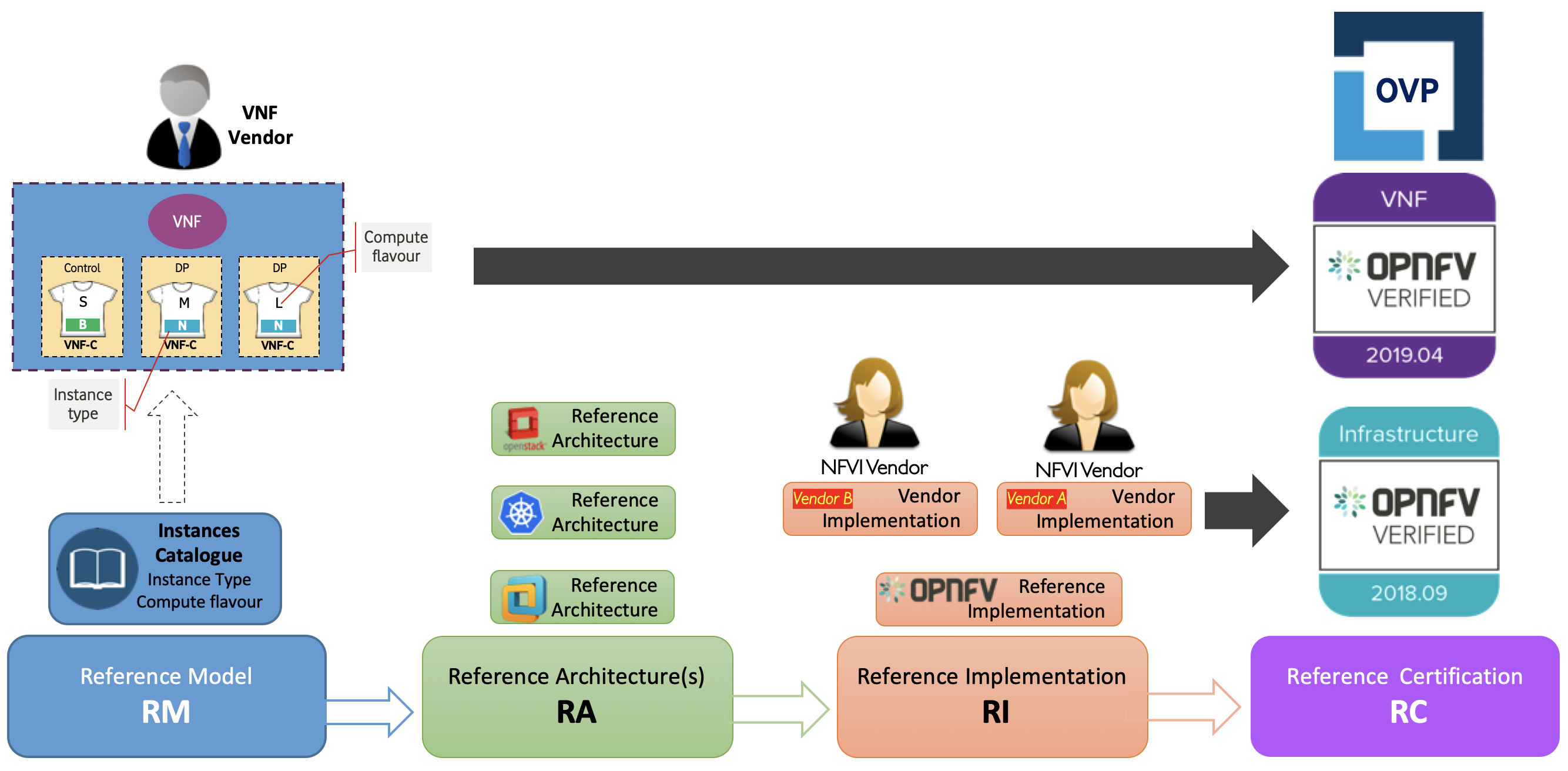
Figure X: The scope of CNTT.
Open Platform for NFV (OPNFV) is a project and community that facilitates a common NFVI, continuous integration (CI) with upstream projects, stand-alone testing toolsets, and a compliance and verification program for industry-wide testing and integration to accelerate the transformation of enterprise and service provider networks. Participation is open to anyone, whether you are an employee of a member company or just passionate about network transformation.
Functest and X-testing: The Functest project provides comprehensive testing methodology, test suites and test cases to test and verify OPNFV Platform functionality that covers the VIM and NFVI components.This project uses a "top-down" approach that will start with chosen ETSI NFV use-case/s and open source VNFs for the functional testing. The approach taken will be to
This project will develop test suites that cover detailed functional test cases, test methodologies and platform configurations which will be documented and maintained in a repository for use by other OPNFV testing projects and the community in general. Developing test suites will also help lay the foundation for a test automation framework that in future can be used by the continuation integration (CI) project (Octopus). Certain VNF deployment use-cases could be automatically tested as an optional step of the CI process. The project targets testing of the OPNFV platform in a hosted test-bed environment (i.e. using the OPNFV test labs world wide).
The X-testing aspect intends to integrate many test projects into a single, lightweight framework for automation that leverages the existing test-api and testdb for publishing results.OPNFV leverages globally distributed community labs provided by member organizations. These labs are used by both developers of OPNFV projects as well as the extensive CI/CD tooling to continuously deploy and test OPNFV reference stacks. In order to ensure a consistent environment across different labs, OPNFV community labs follow a lab specification (Pharos spec) defining a high-level hardware configuration and network topology. In the context of CNTT reference implementations, any updates will be added to the Pharos specification in future releases.

Figure X: The scope of OPNFV.
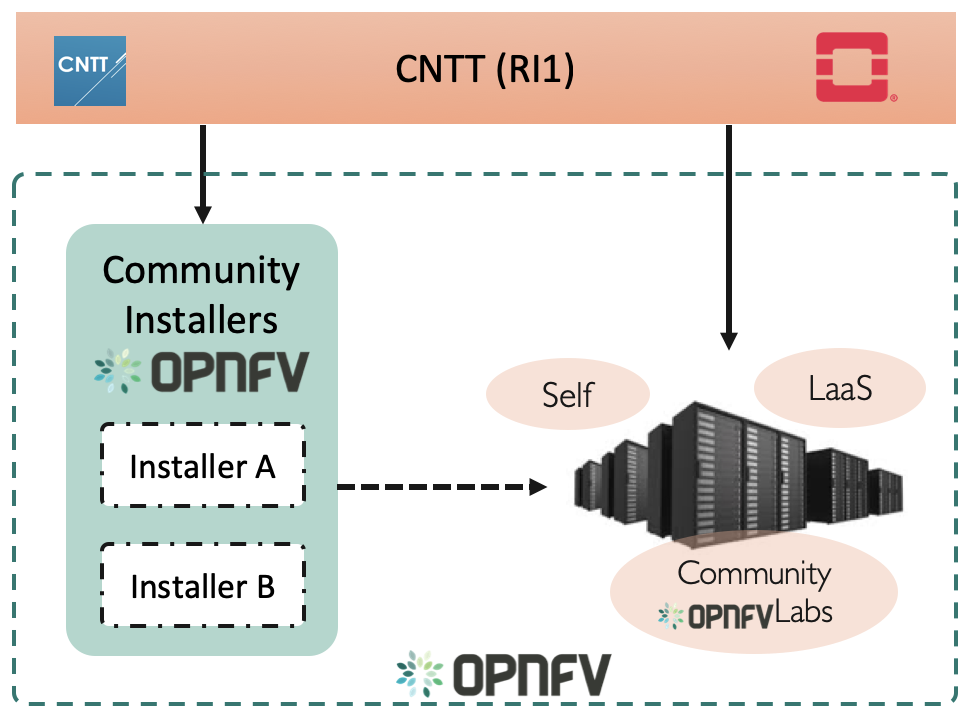
Figure X: Relation of CNTT OpenStack RI and OPNFV.
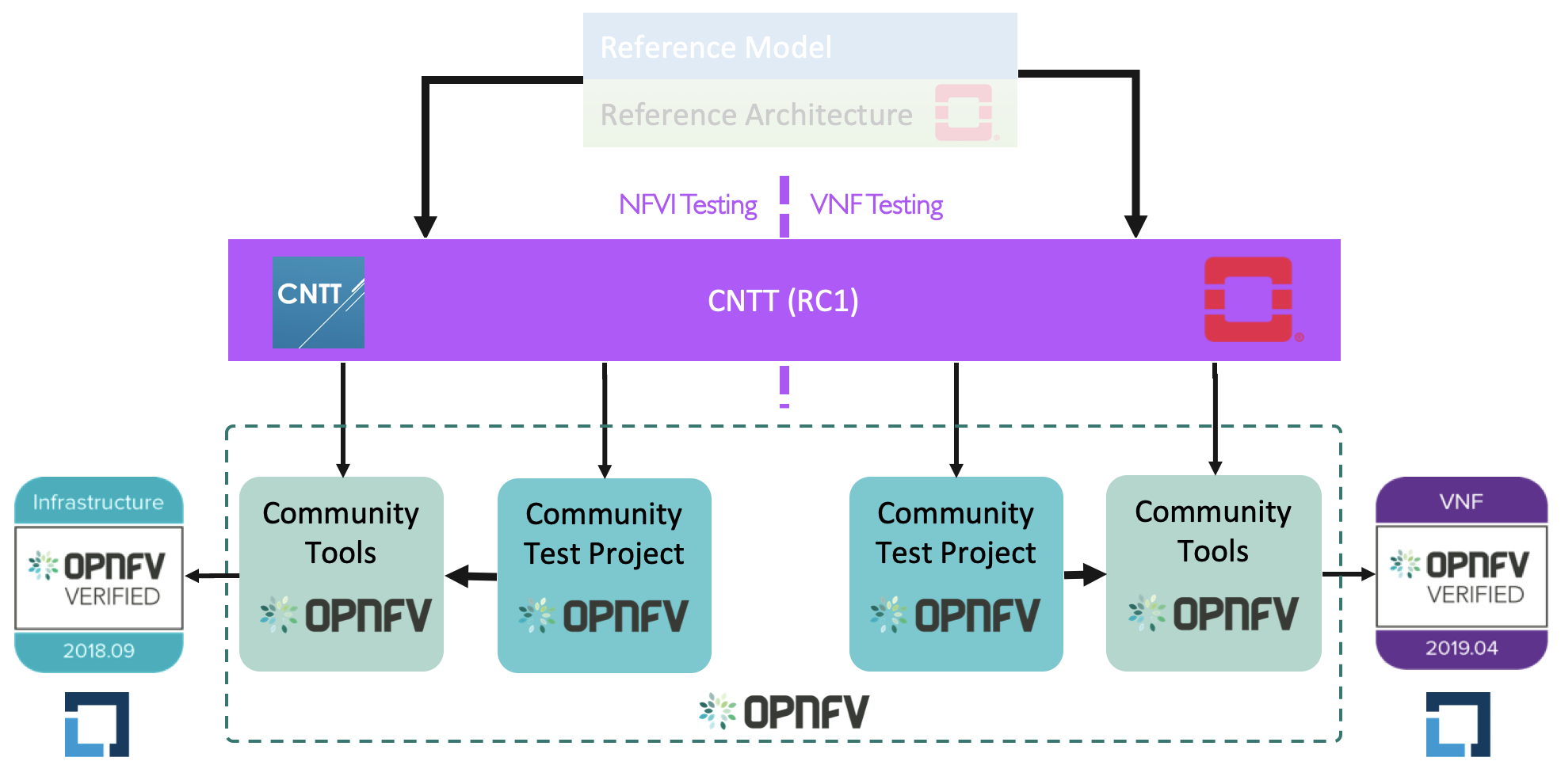
Figure X: Relation of CNTT OpenStack RC and OPNFV/CVC.
Editor: Donald Hunter
Innovation in the big data space is extremely rapid, but composing the multitude of technologies together into an end-to-end solution can be extremely complex and time-consuming. The vision of PNDA is to remove this complexity, and allow you to focus on your solution instead. PNDA is an integrated big data platform for the networking world, curated from the best of the Hadoop ecosystem. PNDA brings together a number of open source technologies to provide a simple, scalable, open big data analytics platform that is capable of storing and processing data from modern large-scale networks. It supports a range of applications for networks and services covering both the Operational Intelligence (OSS) and Business intelligence (BSS) domains. PNDA also includes components that aid in the operational management and application development for the platform itself.
The current focus of the PNDA project is to deliver a fully cloud native PNDA data platform on Kubernetes. Our focus this year has been migrating to a containerised and helm orchestrated set of components, which has simplified PNDA development and deployment as well as lowering our project maintenance cost. Our current goal with the Cloud-native PNDA project is to deliver the PNDA big data experience on Kubernetes in the first half of 2020.
PNDA provides the tools and capabilities to:
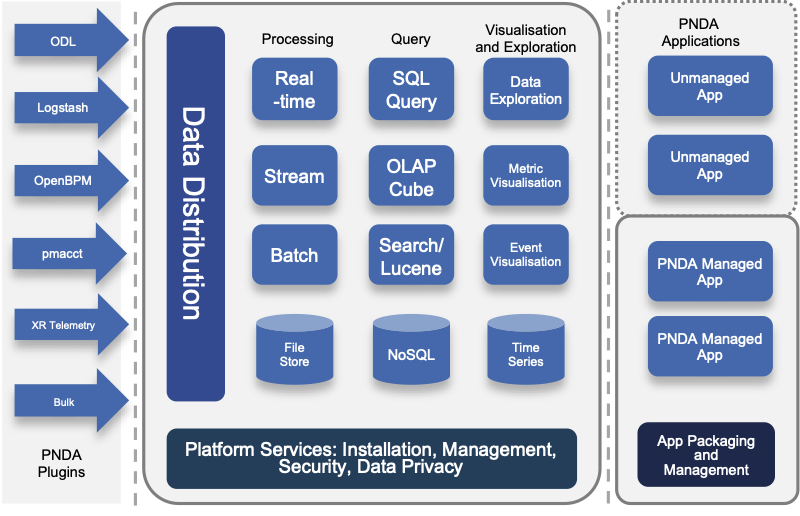
The PNDA dashboard provides an overview of the health of the PNDA components and all applications running on the PNDA platform. The health report includes active data path testing that verifies successful ingress, storage, query and batch consumption of live data.
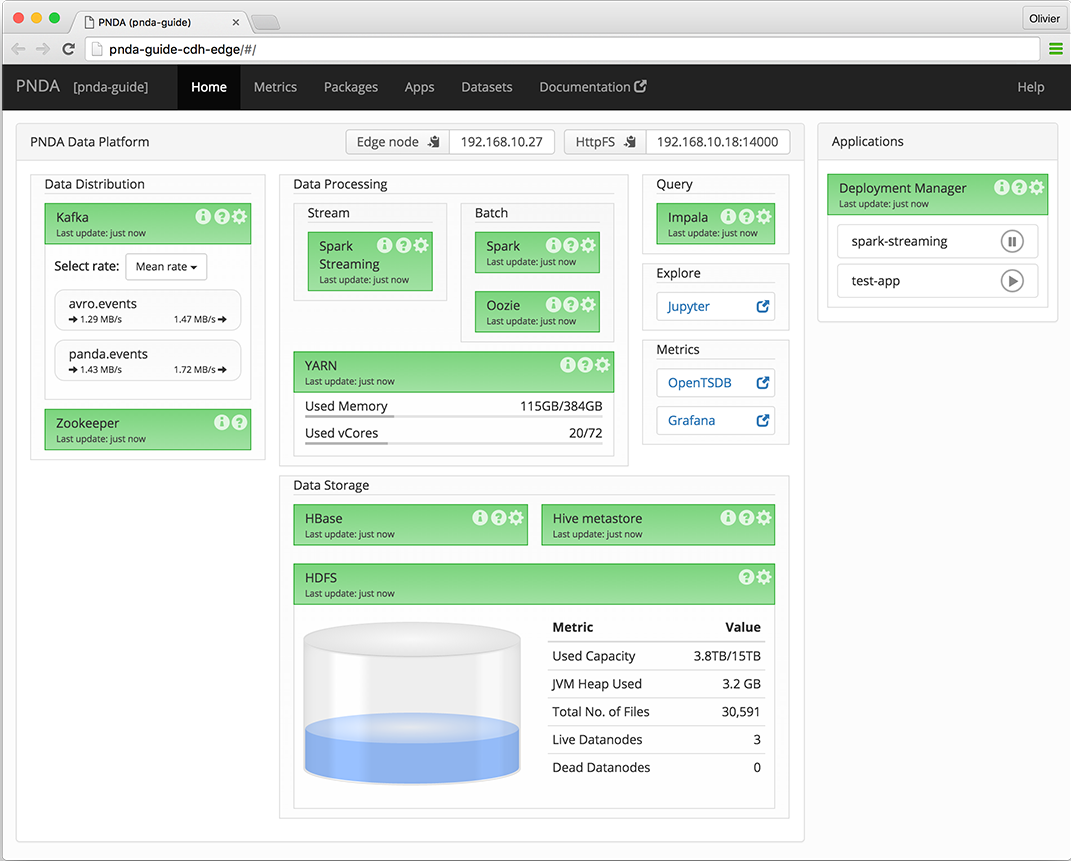
Editor: Prabhjot Singh Sethi
Tungsten Fabric provides a highly scalable virtual networking and security platform that works with a variety of virtual machine and container orchestrators, integrating them with physical networking and compute infrastructure. It is designed to support multi-tenant networks in the largest environments while supporting multiple orchestrators simultaneously.
Tungsten Fabric enables usage of same controller and forwarding components for every deployment, providing a consistent interface for managing connectivity in all the environments it supports, and is able to provide seamless connectivity between workloads managed by different orchestrators, whether virtual machines or containers, and to destinations in external networks.
Tungsten Fabric controller integrates with cloud management systems such as OpenStack or Kubernetes. Its function is to ensure that when a virtual machine (VM) or container is created, it is provided with network connectivity according to the network and security policies specified in the controller or orchestrator.
Tungsten Fabric consists of two primary pieces of software
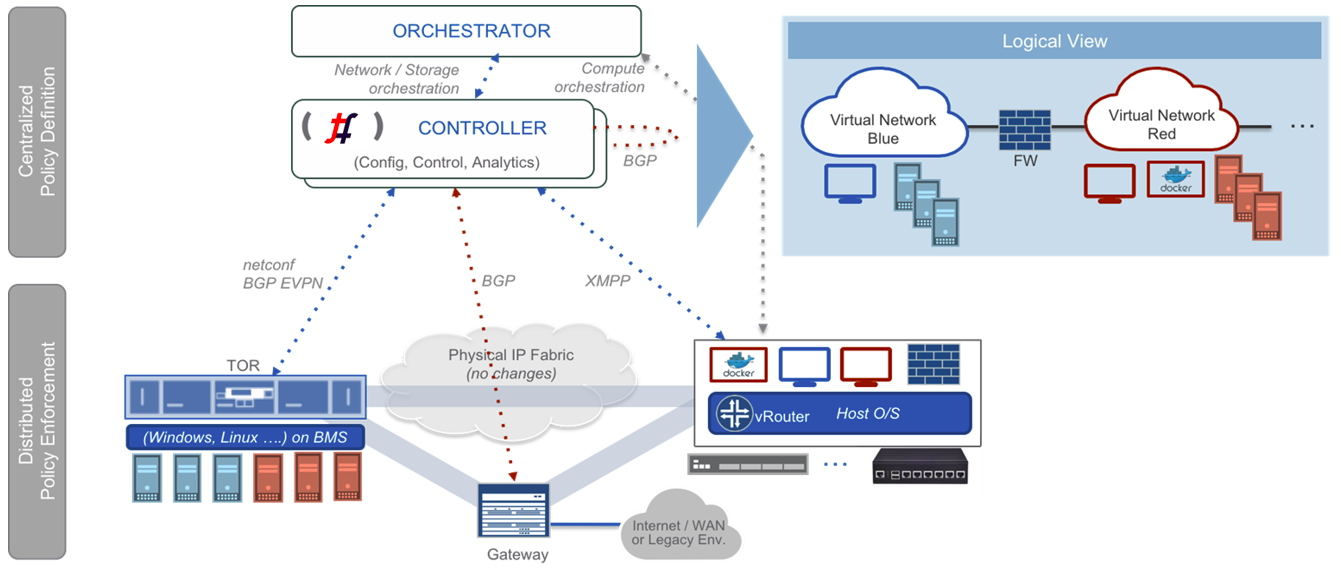
Tungsten Fabric uses networking industry standards such as BGP EVPN control plane and VXLAN, MPLSoGRE and MPLSoUDP overlays to seamlessly connect workloads in different orchestrator domains. For example, virtual machines managed by VMware vCenter and containers managed by Kubernetes.
Tungsten Fabric supports four modes of datapath operation:
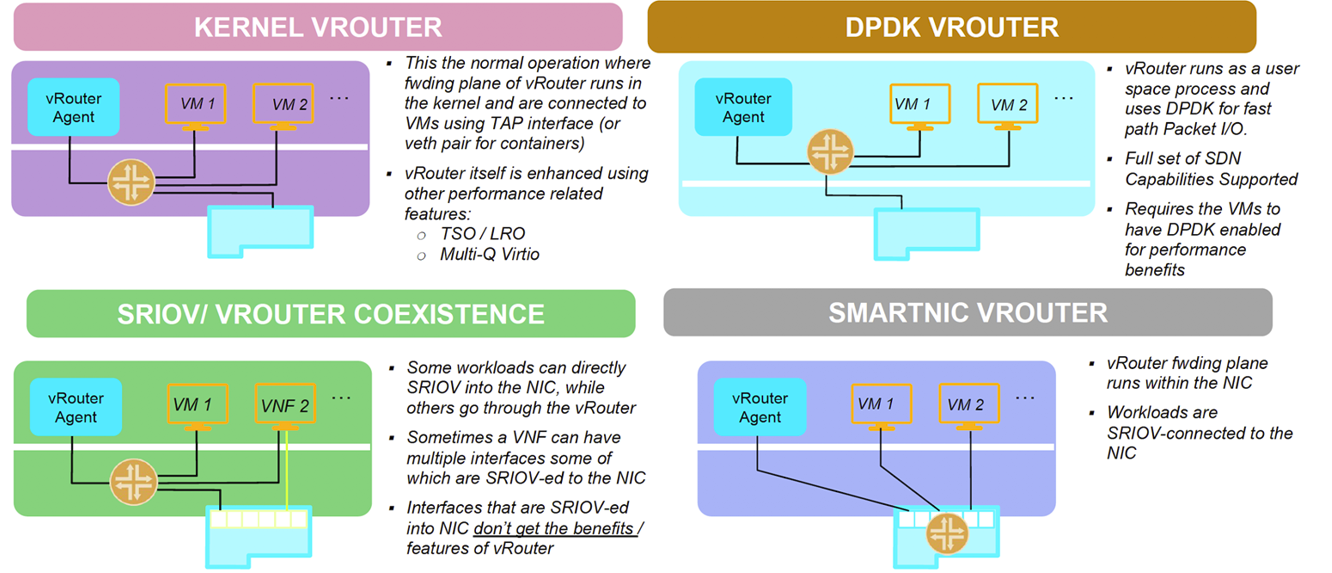
Tungsten Fabric connects virtual networks to physical networks:
Tungsten Fabric manages and implements virtual networking in cloud environments using OpenStack and Kubernetes orchestrators. Where it uses overlay networks between vRouters that run on each host. It is built on proven, standards-based networking technologies that today support the wide-area networks of the world’s major service providers, but repurposed to work with virtualized workloads and cloud automation in data centers that can range from large scale enterprise data centers to much smaller telco POPs. It provides many enhanced features over the native networking implementations of orchestrators, including:
Editor: <TBD>
Streaming Network Analytics System (project SNAS) is a framework to collect, track and access tens of millions of routing objects (routers, peers, prefixes) in real time.
SNAS extracts data from BGP routers using a BGP Monitoring Protocol (BMP) interface. The data is parsed and made available to consumers through a Kafka message bus. Consumers applications in turn can perform further analytics and visualization of the topology data.